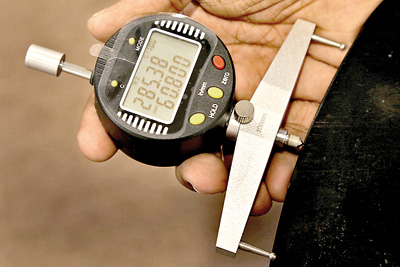In the beginning was an arch gone wrong
Determined to show the mason who was building his house that the entrance didn’t look quite right, Dinesh Katugampala invents a device to measure radius
The Radius Meter was invented because Dinesh Katugampala wanted to prove his builder wrong. As good a reason as any, you may think – although by the time he finished building the device, his baas had moved on. Nevertheless, for his efforts the inventor has an all new mathematical theory to his name, and a device that could potentially change how the engineering and manufacturing industries (among others) work.

The Radius Meter: Changing the face of engineering and manufacturing industries. Pix by M.A. Pushpa Kumara
“Autonomation,” he corrects us gently when we say ‘automation’. “That’s what we call automation with a human touch.” Katugampala, an autonomation engineer with MAS Research and Innovation, was recently shortlisted for the 2015 cycle of the Ray Awards for his Radius Meter.
The Radius Meter is simply a device that can (with the use of a calculation that utilizes a theory known as the Square Dual Theorem) measure the radius of an arch by aligning itself to any point of the circumference. Traditionally, the radius is measured using the centre point of a circle-“we can measure linear lengths and 3D spheres,” says Katugampala. “But there is no in between-nothing that can be utilized to measure the radius of an arc.”
In fact, it was an arch that inspired the invention of the meter in the first place. “We were building our house and there was one arch at the entrance to the sitting room that somehow seemed wrong, like it was not consistent all the way.” His mason denied any imperfection, insisting that the arch was perfectly formed. Katugampala, never one to let a hypothesis go untested, decided he would solve the problem in the best way he knew-mathematically.
“I’ve always been interested in invention and mathematics,” he smiles. “When I was around five or six years old, I remember trying to experiment with gravity using sand and water.” In school (Bomiriya Central College) he was part of the Inventors Club and remembers inventing with friends a bio-gas supply system that powered the school cafeteria. Later, as a Science Society student of D.S. Senanayake College, Katugampala remembers using a copper and zinc reaction to create brass coins that appeared startlingly similar to gold, much to their delight.

Dinesh Katugampala
Following his Advanced Level examinations Katugampala studied for a National Diploma in Technology offered by the University of Moratuwa (unfortunately, he didn’t receive entrance to the Faculty of Engineering, and briefly dabbled in banking before realizing “it was not for me”). At Moratuwa he studied Textiles and Engineering, going on to qualify for a Masters in Operations Management at Indira Gandhi University in India. He was employed by MAS, and the company encouraged Katugampala to pursue his interests in invention-which leads us to his Radius Meter.
The first model of the meter, which he developed utilizing the Square Dual Theorem in 2008, was a crude approximation of the polished, digitized version before us today. The formula that he devised used the Pythagoras theory to derive its eventual conclusion, and “can be understood with some effort by anyone with knowledge in mathematics,” he says. That first model (a wooden cross with a reader in the middle) he used to measure the arch at his home, noting the inconsistency in the arch’s radii all the way through (“I was right!”).
The Radius Meter has now evolved into a fully digitized and commercially sold model. It can directly read the radius of an arc or sphere internally or externally, plot a major arc or circle using only a minor arc, and check the accuracy of an arc’s curvature. It is the first of its kind to do so and is thus a conceptual model, rather than an improvement on an existing model.
Katugampala has already been commissioned by the Archaeology Department of the University of Kelaniya to supply the Radius Meter in order to measure circular objects found at digs. He also supplies his innovation to a tyre manufacturing company and says that the meter is versatile thus making it useful for a number of industries. Moreover, the meter can be used by anyone thanks to simplified operation and its compact, lightweight nature.
For the Radius Meter Katugampala was awarded the President’s Award for Innovation in Physics in 2011 (gold), and a silver medal in the field of industrial equipment at Inventions Geneva 2012, the global innovation exhibition organized by the World Intellectual Property Organization (WIPO). Being shortlisted for the Ray, he says, is an honour. “Ray Wijewardene is someone I’ve always admired. He’s one of the few Lankan inventors who’ve been able to take their invention and make it commercial on a mass scale. Hopefully, I’ll be able to do that one day.”


